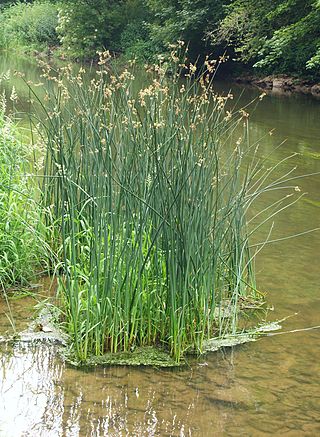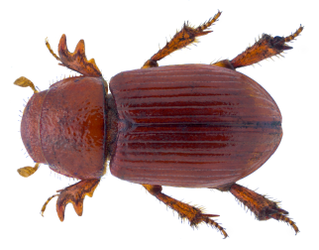
Ruellia is a genus of flowering plants commonly known as ruellias or wild petunias. They are not closely related to petunias (Petunia) although both genera belong to the same euasterid clade. The genus was named in honor of Jean Ruelle (1474–1537), herbalist and physician to Francis I of France and translator of several works of Dioscorides.

Limoniidae is the largest of four crane fly families, with more than 10,700 species in more than 150 genera. Some studies have suggested it to be a paraphyletic group, with some limoniids being more closely related to Tipulidae and Cylindrotomidae than to other limoniids. Limoniid crane flies can usually be distinguished by the way the wings are held at rest. Limoniids usually hold/fold the wings along the back of the body, whereas other crane flies usually hold them out at right angles. Snow flies such as Chionea scita have no wings at all. Limoniids are also usually smaller than other crane flies, with some exceptions.

Iris lacustris, the dwarf lake iris, is a plant species in the genus Iris, subgenus Limniris and in the section Lophiris. It is a rhizomatous, beardless perennial plant, native to the Great Lakes region of eastern North America. It has lavender blue or violet-blue flowers, a very short stem and long fan-like green leaves. It is cultivated as an ornamental plant in temperate regions. It is closely related to Iris cristata.

Lake Kutubu is the second-largest lake in Papua New Guinea, after Lake Murray, and, at 800 m above sea level, the largest upland body of water, with an area of 49.24 km², and a total catchment area of 250 km². Lake Kutubu and Lake Sentani form an ecoregion on the WWF's Global 200. Kutubu lies in the Southern Highlands Province of Papua New Guinea, east of the Kikori River into which it drains, and about 50 km southwest of Mendi, the provincial capital. It is one of the few lakes in the country that occurs in a depression in the rugged interior mountains. The lake has a few islands, the largest of which is Wasemi in its northern part. The water of Lake Kutubu, fed by several streams originating mostly from underground sources, is clear and reaches a depth of 70 m (230 feet). The catchment is inhabited by two main ethnic groups, the Foe to the south and the Fasu to the north. Thirty-three villages lie in the catchment area, with a total estimated population of 10,885.
Aegialia concinna is a species of beetle in family Scarabaeidae. It is endemic to the United States.

Aegialia is a genus of aphodiine dung beetles in the family Scarabaeidae.

Acroloxus lacustris, or the lake limpet, is a small freshwater limpet or snail, a species of aquatic gastropod mollusk in the family Acroloxidae.

Friedlanderia cicatricella is a species of moth of the family Crambidae. It is found in Europe.

Amarinus lacustris is a species of freshwater crab from Australia, New Zealand and nearby islands, where it lives in water of various salinities. It grows up to 10 mm (0.4 in) wide, with an H-shaped groove on its back. It is an omnivore and is eaten by crayfish and fish. It was first discovered in Lake Pupuke, near Auckland, and is the only freshwater crab in New Zealand.

Carex lacustris, known as lake sedge, is a tufted grass-like perennial of the sedge family (Cyperaceae), native to southern Canada and the northern United States. C. lacustris us an herbaceous surface-piercing plant that grows in water up to 50 cm (1.6 ft) deep, and grows 50–150 cm (1.6–4.9 ft) tall. It grows well in marshes and swampy woods of the boreal forest, along river and lake shores, in ditches, marshes, swamps, and other wetland habitat. It grows on muck, sedge peat, wet sand or silt, in filtered or full sunlight.

Schoenoplectus lacustris, the lakeshore bulrush or common club-rush, is a species of club-rush that grows in fresh water across Europe and some neighbouring areas.
Aegialia cartwrighti is a species of aphodiine dung beetle in the family Scarabaeidae. It is found in North America.
Aegialia latispina is a species of aphodiine dung beetle in the family Scarabaeidae. It is found in North America.

Rhysothorax is a genus of dung beetles in the family Scarabaeidae, containing only one species, R. rufus. It has at times been classified as a subgenus within Aegialia.
Aegialia spinosa is a species of aphodiine dung beetle in the family Scarabaeidae. It is found in North America.
Aegialia convexa is a species of aphodiine dung beetle in the family Scarabaeidae. It is found in North America.
Aegialia blanchardi is a species of aphodiine dung beetle in the family Scarabaeidae. It is found in North America.
Aegialia conferta is a species of aphodiine dung beetle in the family Scarabaeidae. It is found in North America.
Veselovsky Reservoir is a reservoir on the western Manych River in Rostov-on-Don, Rostov Oblast. Combined with the Proletarsky Reservoir directly upstream, the pair is also referred to as the Manychysky Reservoirs, built between 1932 and 1936 to provide longstanding river flow. The Veselovsky Reservoir is currently used for irrigation, fisheries, water traffic and power generation.










